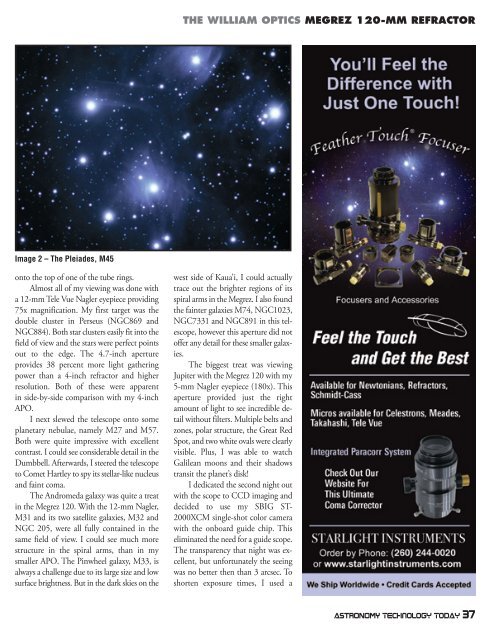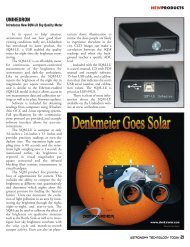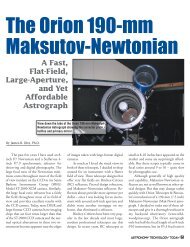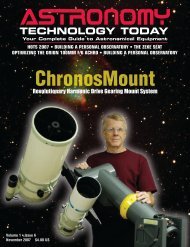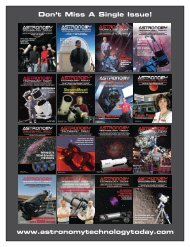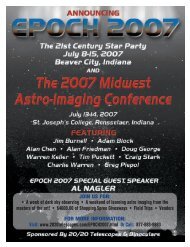magnilux - Astronomy Technology Today
magnilux - Astronomy Technology Today
magnilux - Astronomy Technology Today
Create successful ePaper yourself
Turn your PDF publications into a flip-book with our unique Google optimized e-Paper software.
THE WILLIAM OPTICS MEGREZ 120-MM REFRACTOR<br />
Image 2 – The Pleiades, M45<br />
onto the top of one of the tube rings.<br />
Almost all of my viewing was done with<br />
a 12-mm Tele Vue Nagler eyepiece providing<br />
75x magnification. My first target was the<br />
double cluster in Perseus (NGC869 and<br />
NGC884). Both star clusters easily fit into the<br />
field of view and the stars were perfect points<br />
out to the edge. The 4.7-inch aperture<br />
provides 38 percent more light gathering<br />
power than a 4-inch refractor and higher<br />
resolution. Both of these were apparent<br />
in side-by-side comparison with my 4-inch<br />
APO.<br />
I next slewed the telescope onto some<br />
planetary nebulae, namely M27 and M57.<br />
Both were quite impressive with excellent<br />
contrast. I could see considerable detail in the<br />
Dumbbell. Afterwards, I steered the telescope<br />
to Comet Hartley to spy its stellar-like nucleus<br />
and faint coma.<br />
The Andromeda galaxy was quite a treat<br />
in the Megrez 120. With the 12-mm Nagler,<br />
M31 and its two satellite galaxies, M32 and<br />
NGC 205, were all fully contained in the<br />
same field of view. I could see much more<br />
structure in the spiral arms, than in my<br />
smaller APO. The Pinwheel galaxy, M33, is<br />
always a challenge due to its large size and low<br />
surface brightness. But in the dark skies on the<br />
west side of Kaua’i, I could actually<br />
trace out the brighter regions of its<br />
spiral arms in the Megrez. I also found<br />
the fainter galaxies M74, NGC1023,<br />
NGC7331 and NGC891 in this telescope,<br />
however this aperture did not<br />
offer any detail for these smaller galaxies.<br />
The biggest treat was viewing<br />
Jupiter with the Megrez 120 with my<br />
5-mm Nagler eyepiece (180x). This<br />
aperture provided just the right<br />
amount of light to see incredible detail<br />
without filters. Multiple belts and<br />
zones, polar structure, the Great Red<br />
Spot, and two white ovals were clearly<br />
visible. Plus, I was able to watch<br />
Galilean moons and their shadows<br />
transit the planet’s disk!<br />
I dedicated the second night out<br />
with the scope to CCD imaging and<br />
decided to use my SBIG ST-<br />
2000XCM single-shot color camera<br />
with the onboard guide chip. This<br />
eliminated the need for a guide scope.<br />
The transparency that night was excellent,<br />
but unfortunately the seeing<br />
was no better then than 3 arcsec. To<br />
shorten exposure times, I used a<br />
<strong>Astronomy</strong> TECHNOLOGY TODAY 37


